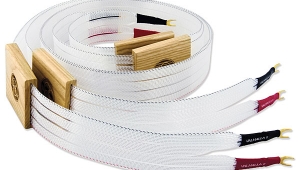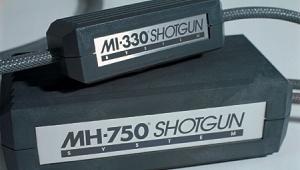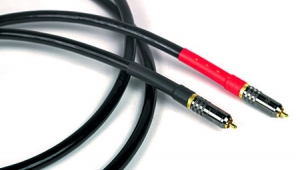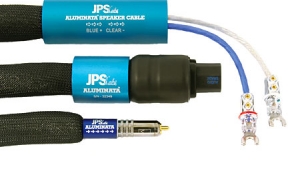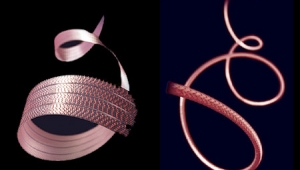| Columns Retired Columns & Blogs |
MIT CVT Terminator 2 interconnect & speaker cable
These are the first interconnects and speaker cables I have reviewed for Stereophile. Each of us has his little niche, and editor John Atkinson likes us to play in the sandboxes we most enjoy. For me, that has usually meant inexpensive speakers and expensive tube electronics. But there's another reason I've tended to shy away from cables.
Footnote 1: Expert Stylus and Cartridge Company, Omega House, 50 Harriotts Lane, Surrey KT212QB, England, UK. Tel: (44) (0)1372-276604. E-mail: info@expertstylus.co.uk.

About 15 years ago, there was an explosion of new cable companies, each of which appeared to be boasting that its innovative designs were right and everyone else's were wrong. Some of these cables were interesting, but many seemed to be nothing more than expensive tone controls. Representatives of these firms accosted reviewers at audio shows, offering to send us their new wires "to play with." One sure way a manufacturer can piss off a reviewer is to send along an unsolicited sample of a product and quickly follow it up with a phone call: "Are you going to review it? If not, can you at least tell me what you think of it?" By telling these manufacturers "I don't do cables," I've been able to keep them at bay for years.
But recently, when JA asked me to review some new intermediate-priced cables from MIT Cables, he closed with "Please say yes." I've had enough experience in the corporate world to recognize that when my boss asks me in writing to do something and I say no, I'd better have a damn good reason. I didn't.
I should also speak a bit about reviewing biases. I've prided myself over the years on having no particular biases regarding equipment. Although I love every piece of gear I own and tend to hold on to gear a very long time (at one point, every component in my reference system had been discontinued), if I hear something new that clearly outperforms what I own and I can afford it, I unflinchingly make the change. But my current reference system includes two components for which I admit to a bias.
First, 20 years ago, I so deeply fell in love with the sound of my original Koetsu Urushi cartridge that I immediately bought a second one. Although I've since heard many other cartridges that have impressed me, I've never had any desire to abandon the Koetsus. Thanks to several subsequent rebuilds by the Expert Stylus and Cartridge Company (footnote 1), my Urushis continue to hold court in my reference system.
I am also biased toward the cables made by Music Interface Technologies (MIT). In 1982, I heard MIT founder Bruce Brisson's first design for Monster Cable, the Interlink Reference A interconnect, which introduced the world to Brisson's phase-correct and time-coherent Balanced Bandwidth technology. At the time, this interconnect made every other sound wrong to me. It was neutral, detailed, and rendered transients the way they sounded in live music. Over the years, I've upgraded my interconnects with newer, more expensive Brisson designs: first the 330SG, then the MI-350 CVTwin Terminator, and now the Magnum M3. Each upgrade has brought more inner detail, wider bandwidth, and a more organic, less mechanical sound. From time to time, friends have brought me cables to try in my reference system. While never actually disliking any of them, I've always preferred my MITs.
I was an early adopter of Brisson's original MH-750 "music hose" speaker cable and also became a fan and owner of Brisson's budget speaker cables and interconnects, from the Terminator 2, 3, 5, and 6 lines. All share Brisson wires' usual absence of sonic signature, but lack the bandwidth and resolution of detail of his more expensive models.
However, MIT's more expensive speaker cables of the late 20th century tended to be optimized either for solid-state or tube amplifiers; as a reviewer, I needed a cable that would work equally well with all amps. So I switched to Acarian Systems' Black Orpheus, which I viewed as an extension of Acarian's Al¢n Circe loudspeaker, which is internally wired with Black Orpheus-and I own a pair of Circes. The Black Orpheus turned out to be a detailed, neutral cable that greatly eased my job of reviewing affordable speakers.
All of Bruce Brisson's current designs are based on MIT's patented Multipole network technology. The theory is that standard cables have a very narrow frequency range within which the cable is "articulating ideally," as Brisson puts it. He refers to such a cable as a "single-pole" design. Brisson adds network interfaces to his cables that increase the number of articulation "poles," resulting in a broadening of the frequency range within which that cable is "articulating ideally." The higher the number of poles, the more elaborate the network and the more expensive the cable-MIT's Oracle biwire speaker cable has 75 poles and costs $24,900 per 8' pair.
The CVT Terminator 2 cable reviewed here has additional networks that Brisson has integrated with the output networks found in the affordable Terminator 2 and 3 cables, which, MIT claims, results in a wider "articulation" bandwidth than older designs. However, in this "hybrid" cable, MIT has also added the CVT Coupler input module, which was previously found in its more expensive Reference products. The CVT input module is designed to minimize the extent to which the cables reflect energy back to the source component. The marriage of these two technologies results in increasing the number of articulation poles available at the price: 9 poles for the interconnect, 15 for the speaker cable, and 16 for the biwire speaker cable.
System
I tested the MIT cables in my affordable reference system, using the CVT Terminator 2 interconnect ($499/1m pair) to join my Creek Destiny CD player and Destiny integrated amplifier. The CVT Terminator 2 single-wire speaker cable ($999/8' pair) drove the Nola Mini speakers, and the CVT 2 biwire version ($1299/8' pair) fed the Monitor Audio Silver RS6 speakers. (Because my expensive reference system requires balanced interconnects and triwired speaker cable, I couldn't use it to test the MITs.)
I listened to the interconnects and speaker cables individually and together, and compared the interconnects to my MI-350 CVTwin Terminators (which, as I recall, cost about $1800/pair when I bought them in 1995), and the biwire cables to the Acarian Black Orpheus ($400/10' pair when available).
CVT Terminator 2 speaker cable
My jazz quartet Attention Screen's CD, Live at Merkin Hall (Stereophile STPH018-2), brought out the CVT 2's best. When, two months before the recording, JA and I checked out Merkin, I was told I had a choice between the hall's two Steinway D pianos. They sounded and felt quite different; the one I chose had a uniquely involving quality of silky richness that I found intoxicating. Less than a minute into the CD's first track, "Mansour's Gift," it became obvious that I was again listening to that special piano-every timbral nuance and low-level dynamic detail was preserved intact, with no trace of coloration. During very-low-level passages, I found myself analyzing bassist Chris Jones's technique and effects settings. The cable's dynamic articulation and shimmering, delicate high-frequency reproduction enabled me to focus intensely on the upper-register piano passages as I simultaneously got lost in and critiqued my own performance.
Footnote 1: Expert Stylus and Cartridge Company, Omega House, 50 Harriotts Lane, Surrey KT212QB, England, UK. Tel: (44) (0)1372-276604. E-mail: info@expertstylus.co.uk.
- Log in or register to post comments




